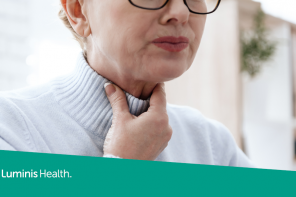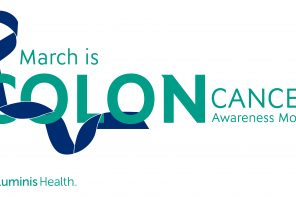May is Skin Cancer Awareness Month, making it a good time to brush up on skin cancer facts. So, before you put dibs on your lounge chair for the pool season, learn more about how to spot — and prevent — skin cancer, using these tips from Dr. Walid El Ayass, medical oncologist at the Luminis Health Center for Cancer and Blood Disorders.
After months of doing more hiding than shining, the sun’s finally coming out to play. Sunshine in the right doses is good for us—it increases serotonin, the brain’s mood-boosting hormone that helps us feel calm and focused. It also boosts vitamin D, which helps keep bones strong. But heavy doses of sunshine? It turns out that “too much of a good thing” can cause skin cancer.
What are the types of skin cancer?
There are several types of skin cancer. The most common ones are melanoma and basal cell and squamous cell carcinomas, known as nonmelanoma skin cancer. These cancers develop in the top layer of skin (the epidermis), in areas that get the most sun exposure, like the face, ears, neck, arms and hands.
Basal cell carcinoma
About 80% of skin cancers are basal cell carcinomas. They start in the deeper part of the epidermis in those sun-exposed areas. They’re usually raised, pearly bumps that grow slowly. They rarely spread to other parts of the body, but without treatment, basal cell carcinoma can spread deeper into the skin to the bone.
Squamous cell carcinoma
These cancers start in the upper layer of the epidermis. Along with sun-exposed areas, squamous cell cancers can develop in scars or chronic skin sores. They often look like a rough, scaly, reddish patch. They’re more likely to grow faster and spread than basal cell cancer but can usually be removed or treated and cured.
Melanoma
Melanoma is less common than other cancers, and it’s more dangerous. If not caught early and treated, it’s more likely to spread to other parts of the body. Melanoma starts in the cells that give skin its tan or brown color, so time in the sun plays a big role.
What are the risks of developing skin cancer?
Most people don’t realize that skin cancer is the most common form of cancer in the U.S. One in five Americans will develop skin cancer by the time they’re 70. Anyone can get skin cancer, but some factors put you at greater risk:
- A family history of melanoma
- A history of blistering sunburns as a child or teen
- Blond or red hair
- Blue or green eyes
- Certain types of moles
- Exposure to UV rays from sunlight or indoor tanning over a long period
- A light complexion
What are the signs of skin cancer?
Skin cancer is the only type of cancer you can see. That means you can and should be on the lookout for it. The Skin Cancer Foundation recommends doing head-to-toe self-exams every month. When it comes to looking for skin cancer, remember these three words as your guide:
- New: Look for new growths, moles or blemishes (especially if you’re over age 21).
- Changing: Check if growths are changing in size, color, shape or texture.
- Unusual: Keep an eye out for growths or moles with an unusual outline that itch, hurt, crust or bleed for more than three weeks.
If you see something, do something – talk with your primary care provider. Remember, skin cancer is curable if found early.
How can I reduce my risk of skin cancer?
It’s no secret sun that exposure is the main culprit when it comes to pegging a cause of skin cancer. About 90% of nonmelanoma skin cancers and 86% of melanomas are linked to UV light exposure from the sun. The good news? Reducing your risk of skin cancer doesn’t mean giving up the great outdoors. You can reduce your risk with some simple habits:
- Don’t use tanning beds, booths or sunlamps.
- Enjoy the sun from under an umbrella, especially between 10:00 am – 2 pm when the sun is strongest.
- Use a broad-spectrum sunscreen with an SPF 15 or higher every day. (You get damaging UV rays even on cloudy days.) When you’re in the sun or water, reapply it every two hours.
- Wear sun-protective clothing, UVA- and UVB-blocking sunglasses and wide-brimmed hats.
 Dr. Walid El Ayass is a medical oncologist at the Luminis Health Center for Cancer and Blood Disorders. He specializes in treating breast and gastrointestinal malignancies. To make an appointment with Dr. El Ayass, please call 443-481-4884.
Dr. Walid El Ayass is a medical oncologist at the Luminis Health Center for Cancer and Blood Disorders. He specializes in treating breast and gastrointestinal malignancies. To make an appointment with Dr. El Ayass, please call 443-481-4884. 



